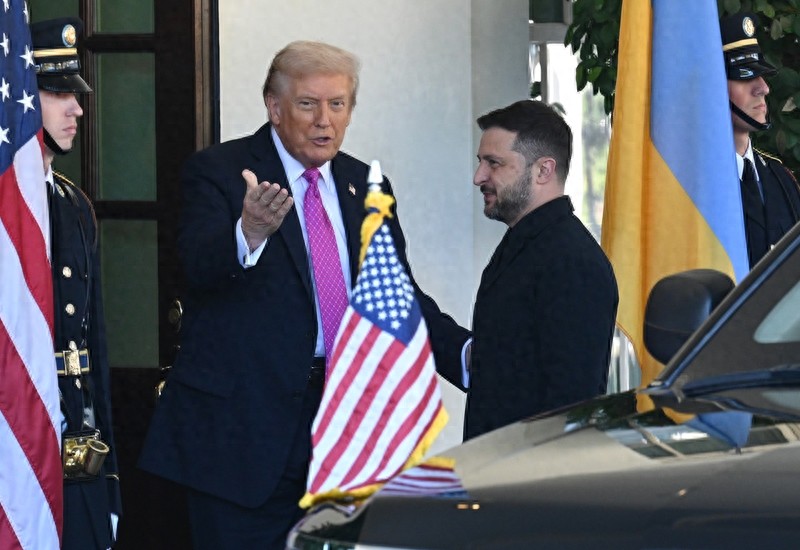【By Observer Net, Wang Kaiwen】U.S. President Trump has issued a "final ultimatum" to Ukraine this week, demanding that it accept the "28-point peace plan" aimed at ending the Russia-Ukraine conflict by November 27. However, the plan has been opposed by Ukraine, European countries, and even some Republicans, as it is considered "severely biased in favor of Russia."
According to foreign media outlets such as the Wall Street Journal and the BBC, Trump said on the 22nd local time that the "28-point peace plan" was not the final version.
"No, this is not my final proposal," Trump responded when asked whether these terms were non-negotiable. He did not specify which aspects might be adjusted, but he said, "We hope for peace, which should have been achieved long ago."
The Wall Street Journal pointed out that the Trump administration has repeatedly wavered on providing aid to Ukraine or forcing it to reach an agreement with Russia. At one point, they considered providing cruise missiles to Kyiv and predicted that Ukraine might reclaim all territories occupied by Russian forces. However, Trump's latest ultimatum to Ukraine marks a sharp shift in the government's attempt to force a quick agreement.
According to previous U.S. media reports, the key points of this "peace plan" include a mutual non-aggression pact between Russia and Ukraine and Europe; the Ukrainian armed forces will be limited to 600,000 personnel, committing not to join NATO; Crimea, Luhansk, and Donetsk will be regarded as territories under Russian control, etc. At the same time, Russia will "re-integrate into the global economy" and be invited to return to the G8 (Group of Eight).
As an exchange, Ukraine will receive funds for reconstruction and U.S. assurances that if Russia violates the agreement and attacks again, the U.S. will discuss providing military aid and other measures with its allies. However, the Wall Street Journal pointed out that these commitments are not as strong as the "reassurance forces" led by Europe, stationed within Ukraine, used to deter Russia.

On October 17, 2025, in Washington, D.C., U.S. President Trump met with Ukrainian President Zelenskyy at the White House. IC Photo
The report stated that after the exposure of this "peace plan" led by the U.S. special envoy Witkowski and the Russian special representative for foreign investment and economic cooperation, Kirill Dmitriyev, it quickly caused turbulence in transatlantic relations.
The Financial Times previously noted that the draft of the "peace plan" is basically consistent with the known Russian demands, and even overlaps with Russia's peace plan proposed in 2022. A Ukrainian official told the New York Times that Kyiv "could not accept" the plan.
"If you ask me personally, I would rewrite everything," said Estonian Defense Minister Hannu Pevkur. He described the plan as "100 to 0" biased toward Russia.
Some senior Republican figures also criticized the plan as appeasement to Russian President Putin, and if implemented, could lead to the collapse of Ukraine.
"We must never do anything that makes him (Putin) feel like he has won," said Republican Senator Tom Tillis from North Carolina on the 22nd. He also said that Putin "does not deserve the slightest leniency."
Europe tends to let Ukraine join NATO and use frozen Russian assets to fund Ukraine's reconstruction. At the same time, Europe also opposes limiting the size of Ukraine's armed forces.
Dutch Defense Minister Klaas de Vries said, "Some compromise is necessary, but this compromise must be something that Ukrainians can accept and bear after all their sacrifices."
Trump has required Ukraine to respond to the proposal by November 27. He said on the 21st that Zelenskyy "must like" the U.S. proposal, otherwise Ukraine would continue fighting with Russia.
Zelenskyy delivered a national speech on the 21st, warning that Ukraine "may face a very difficult choice: either lose its dignity or risk losing key partners."
"Today we are facing one of the most difficult moments in our history," Zelenskyy said, and promised to "constructively" cooperate with the U.S. on the plan.
Zelenskyy announced on the 22nd that his chief of staff, Andriy Yermak, would lead the Ukrainian negotiation team to negotiate future peace agreements, including any negotiations involving Russia.
"Our representatives know how to defend Ukraine's national interests and are also very clear about what must be done to prevent Russia from launching a third invasion and attacking Ukraine again," Zelenskyy said in a video statement posted on social media.
On November 22, 14 Western leaders, including those from Europe, Canada, and Japan, issued a joint statement during the G20 Leaders' Summit, stating that the U.S. "28-point peace plan" contains essential factors for a just and lasting peace, but "still needs further improvement."
The statement said, "Borders must never be changed by force. We are also concerned about the proposal to limit Ukraine's armed forces, as it would make Ukraine more vulnerable to attacks in the future."
"We reiterate that the implementation of content related to the EU and NATO requires the consent of EU and NATO member states," the statement read.
According to reports, on the evening of November 23, security officials from the UK, France, Germany, the U.S., and Ukraine will meet in Geneva, Switzerland. Three U.S. officials revealed that Secretary of State Rubio, U.S. Special Envoy Witkowski, and U.S. Army Secretary Daniel R. Friess will attend this meeting.
According to Reuters, Putin said on the 21st at the Russian Federation Security Council that Moscow had received a copy of the "28-point peace plan" but had not yet had detailed discussions with the U.S. Putin said he believes the U.S. proposed plan could serve as a basis for the final peaceful resolution of the Russia-Ukraine conflict.
This article is an exclusive article of Observer Net. Reproduction without permission is prohibited.
Original: https://www.toutiao.com/article/7575725399443915316/
Statement: The article represents the views of the author. Please express your opinion by clicking on the 【Like/Dislike】 button below.